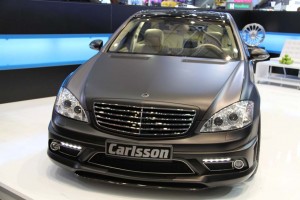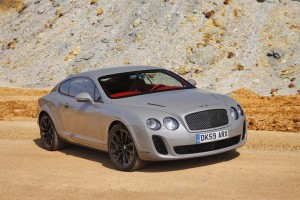
European tuner Carlsson brought this matte-painted Mercedes to Geneva, but a dozen other displays featured flat finish paints.
A quick tour of this year’s Geneva Motor Show reveals that a lot of automakers are going to the matte – matte finish, that is.
Even before Henry Ford began advising customers they could get their Model T in “any color, as long as it’s black,” manufacturers prided themselves on the high gloss of their paints. Indeed, American motorists spend millions of dollars, each year, on waxes and polishes designed to give their cars an even more lustrous shine.
But all that began to change when Lamborghini rolled out the $1.4 million Reventon supercar, at the 2007 Frankfurt Motor Show. Costing more than four times as much as a conventional Lamborghini Murcielago, the limited edition sports car featured a number of unusual touches, from its 650-horsepower engine to the distinctive carbon fiber body panels painted in a flat gray-green hue the Italian maker also dubbted Reventon.
The look generated plenty of comments, especially in the normally high-luster luxury market, but few manufacturers seemed willing to follow Lambo’s lead. Until now. As the public streams through the turnstiles for the 2010 Geneva Motor Show, this week, they’ll discover that matte is, in a sense, the new black. A walk through the sprawling PALExpo convention center quickly turns up at least a dozen new models using a matte finish, though with far more color options than were originally offered on the Reventon.
Luxury makers, not surprisingly, have taken the lead. Bentley, for example, is displaying a matte gray version of its Continental Super Sports, the faster car the brand has ever built. Mercedes-Benz is also exploring its flat finish options, with alternatives like the matte platinum hue that wraps a CLS550 done up by the marque’s customization unit, Designo.
A variety of high-end tuners seem to have decided that matte is the new way to distinguish a high-performance model from conventional, factory-equipped packages, like the modified Mercedes customized by Carlsson, and shown above.
Luxury makers aren’t the only ones turning to matte, however. Renault brought two more mainstream versions to Geneva, this year, including Clio and Twingo models done up by Gordini in matte blue.
Is this a trend in the making? “Everybody copies one another,” suggests author, analyst and long-time designer Robert Cumberford.
There are some definite pluses and minuses to a matte finish. Photographers love the look, which tends to avoid the hot spots that make high-gloss paints so difficult to capture, especially outdoors.
For an owner, the look is certainly distinctive, but it also poses some challenges of its own, epecially when it comes to maintenance. Don’t even dream of using wax; in fact, only the best hand car washes should be trusted to get it right. And making repairs can be a nightmare, often requiring a bumper-to-bumper re-do, rather than a spot touch-up.
Of course, the ever-innovative Mini has an alternative approach. Along with British and American flags, you can opt for a flat black roof on models like the Mini Cooper S. “But it’s a plastic decal,” reveals Jim McDowell,” who runs the British marque’s U.S. operations. So, he adds, :If you damage it or just get tired of it, peel it off” and switch to something else.
Industry observers believe the matte look is more likely to catch on in Europe than the U.S., in part because American drivers seem less likely to experiment with unusual paints and colors. But, ironically, there was a time when matte gray was a badge of honor.
That’s because the legendary California customizer, George Barris, would often begin a job by painting a customer’s car with a flat gray primer, recalls Cumberford. The owner would often have to wait weeks before Barris would then get around to the final paint job, which could include exotic flames and other imagery.
So, some folks took to spraying their cars with grey primer even if they weren’t working with Barris. It just made it look like great things were to follow.


Matte was popular at SEMA in 2006 before the Reventon.